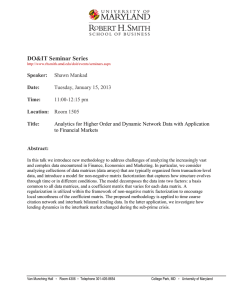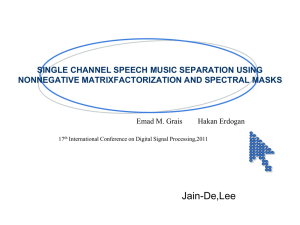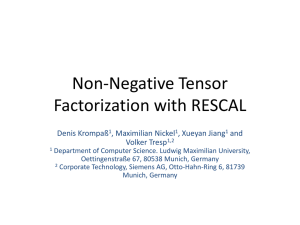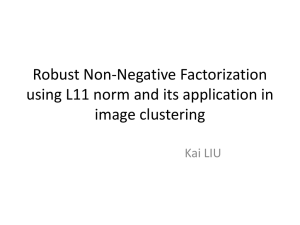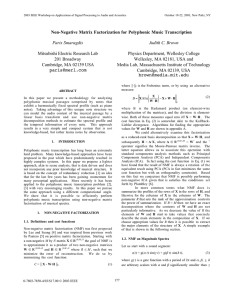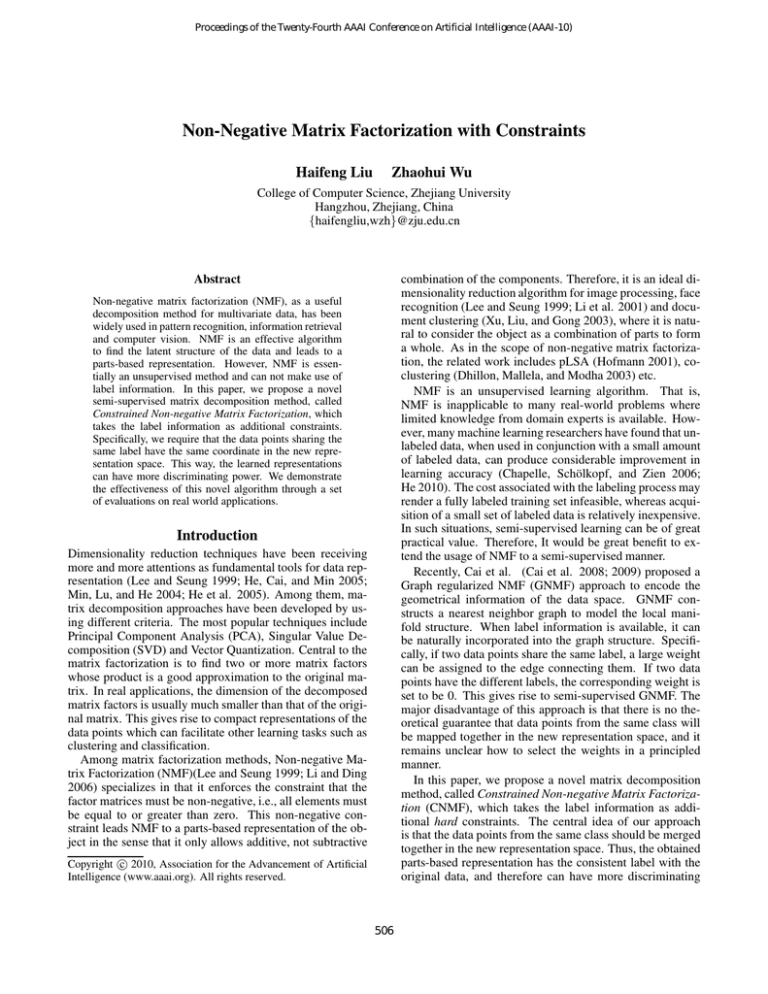
Proceedings of the Twenty-Fourth AAAI Conference on Artificial Intelligence (AAAI-10)
Non-Negative Matrix Factorization with Constraints
Haifeng Liu
Zhaohui Wu
College of Computer Science, Zhejiang University
Hangzhou, Zhejiang, China
{haifengliu,wzh}@zju.edu.cn
Abstract
combination of the components. Therefore, it is an ideal dimensionality reduction algorithm for image processing, face
recognition (Lee and Seung 1999; Li et al. 2001) and document clustering (Xu, Liu, and Gong 2003), where it is natural to consider the object as a combination of parts to form
a whole. As in the scope of non-negative matrix factorization, the related work includes pLSA (Hofmann 2001), coclustering (Dhillon, Mallela, and Modha 2003) etc.
NMF is an unsupervised learning algorithm. That is,
NMF is inapplicable to many real-world problems where
limited knowledge from domain experts is available. However, many machine learning researchers have found that unlabeled data, when used in conjunction with a small amount
of labeled data, can produce considerable improvement in
learning accuracy (Chapelle, Schölkopf, and Zien 2006;
He 2010). The cost associated with the labeling process may
render a fully labeled training set infeasible, whereas acquisition of a small set of labeled data is relatively inexpensive.
In such situations, semi-supervised learning can be of great
practical value. Therefore, It would be great benefit to extend the usage of NMF to a semi-supervised manner.
Recently, Cai et al. (Cai et al. 2008; 2009) proposed a
Graph regularized NMF (GNMF) approach to encode the
geometrical information of the data space. GNMF constructs a nearest neighbor graph to model the local manifold structure. When label information is available, it can
be naturally incorporated into the graph structure. Specifically, if two data points share the same label, a large weight
can be assigned to the edge connecting them. If two data
points have the different labels, the corresponding weight is
set to be 0. This gives rise to semi-supervised GNMF. The
major disadvantage of this approach is that there is no theoretical guarantee that data points from the same class will
be mapped together in the new representation space, and it
remains unclear how to select the weights in a principled
manner.
In this paper, we propose a novel matrix decomposition
method, called Constrained Non-negative Matrix Factorization (CNMF), which takes the label information as additional hard constraints. The central idea of our approach
is that the data points from the same class should be merged
together in the new representation space. Thus, the obtained
parts-based representation has the consistent label with the
original data, and therefore can have more discriminating
Non-negative matrix factorization (NMF), as a useful
decomposition method for multivariate data, has been
widely used in pattern recognition, information retrieval
and computer vision. NMF is an effective algorithm
to find the latent structure of the data and leads to a
parts-based representation. However, NMF is essentially an unsupervised method and can not make use of
label information. In this paper, we propose a novel
semi-supervised matrix decomposition method, called
Constrained Non-negative Matrix Factorization, which
takes the label information as additional constraints.
Specifically, we require that the data points sharing the
same label have the same coordinate in the new representation space. This way, the learned representations
can have more discriminating power. We demonstrate
the effectiveness of this novel algorithm through a set
of evaluations on real world applications.
Introduction
Dimensionality reduction techniques have been receiving
more and more attentions as fundamental tools for data representation (Lee and Seung 1999; He, Cai, and Min 2005;
Min, Lu, and He 2004; He et al. 2005). Among them, matrix decomposition approaches have been developed by using different criteria. The most popular techniques include
Principal Component Analysis (PCA), Singular Value Decomposition (SVD) and Vector Quantization. Central to the
matrix factorization is to find two or more matrix factors
whose product is a good approximation to the original matrix. In real applications, the dimension of the decomposed
matrix factors is usually much smaller than that of the original matrix. This gives rise to compact representations of the
data points which can facilitate other learning tasks such as
clustering and classification.
Among matrix factorization methods, Non-negative Matrix Factorization (NMF)(Lee and Seung 1999; Li and Ding
2006) specializes in that it enforces the constraint that the
factor matrices must be non-negative, i.e., all elements must
be equal to or greater than zero. This non-negative constraint leads NMF to a parts-based representation of the object in the sense that it only allows additive, not subtractive
c 2010, Association for the Advancement of Artificial
Copyright Intelligence (www.aaai.org). All rights reserved.
506
power. Another advantage of our approach is that it is parameter free, which avoids the cost of tuning parameters in
order to get the best result. It makes our algorithm applicable to many real world applications easily and efficiently.
We also discuss how to solve the corresponding optimization
problem efficiently.
that the data points sharing the same label can be mapped
into the same class in the low-dimensional space. The algorithm presented in this paper is fundamentally motivated
from semi-supervised graph embedding (He, Ji, and Bao
2009) which also consider label information as additional
constraints.
A Review of NMF
The Objective Function
Consider a data set consisting of n data points {xi }ni=1 ,
among which the label information is available for the first
l data points x1 , · · · , xl , and the rest n − l data points
xl+1 , · · · , xn are unlabeled.
Suppose there are c classes. Each data point from
x1 , · · · , xl is labeled with one class. We first build an l × c
indicator matrix C where ci,j = 1 if xi is labeled with the
j-th class; ci,j = 0 otherwise. With the indicator matrix C,
we define a label constraint matrix A as follows:
Cl×c
0
A=
0
In−l
Non-negative Matrix Factorization (NMF) (Lee and Seung
2001) is an unsupervised learning algorithm used to decompose multivariate data under the constraint that all entries in
the decomposed matrix factors have to be non-negative.
Suppose we have n data points {xi }ni=1 . Each data point
xi ∈ Rm is m-dimensional and is represented by a vector.
The vectors are placed in the columns and the whole data
set is represented by a matrix X = [x1 , · · · , xn ] ∈ Rm×n .
NMF aims to find two non-negative matrix factors U and V
where the product of the two factors is an approximation of
the original matrix, represented as:
X ≈ UVT
(1)
The approximation is quantified by a cost function which
can be constructed by some distance measure. If we take
the Frobenius norm as an example, the goal of NMF can be
restated as follows: to factor X into an m × k matrix U and
a k ×n matrix VT such that the following objective function
is minimized:
O = kX − UVT k
(2)
This objective function is not convex in both variables U
and V. Thus, it is hard to find the global minima for O.
Lee and Seung proposed an iterative update algorithm (Lee
and Seung 2001) to find the locally optimal solution for the
above optimization problem.
In the NMF factorization, each column vector of U, ui ,
can be regarded as a basis and each data point xi is approximated by a linear combination of these k bases, weighted
by the components of V. In other words, NMF maps each
data xi to vi from m-dimensional space to k-dimensional
space. The new representation space is spanned by the k
bases ui . In real applications such as image processing (Lee
and Seung 1999), face recognition (Li et al. 2001) (Liu,
Zheng, and Lu 2003) and document clustering (Xu, Liu, and
Gong 2003), we usually set k ≪ m and k ≪ n. Then the
high dimensional data can be represented by a set of lowdimensional vectors in the hope that the basis vectors can
discover the latent semantic structure among the data set.
Different from other dimension reduction algorithms such as
PCA, LDA and LPP (He and Niyogi 2003), the non-negative
constraints on U and V only permit the additive combination of the basis vectors, which is the reason why NMF is
considered as the parts-based representation.
where In−l is a (n − l) × (n − l) identity matrix. Recall that
NMF maps each data point xi to vi from m-dimensional
space to k-dimensional space. To incorporate the label information, we can impose the label constraints by introducing
an auxiliary matrix Z:
V = AZ
(3)
From the above equation, it is easy to check that if xi and
xj have the same label, then vi = vj .
With the label constraints, our CNMF algorithm reduces
to minimize the following objective function
O
=
kX − UVT k
=
kX − U(AZ) k
=
kX − UZT AT k
T
(4)
with the constraint that ui,j and zi,j are non-negative. Since
Z is non-negative, it is easy to see that V is also nonnegative.
The Algorithm
The objective function of CNMF in Eq. (4) is not convex
in both variables U and Z. It is, thus, unrealistic to find
the global minima for O. Int the following, we describe an
iterative updating algorithm to obtain the local optima of O.
Using the matrix property Tr(AB) = Tr(BA), the objective function O can be rewritten as:
O
NMF with Constraints
NMF is an unsupervised learning algorithm. It can not be
applied directly to the situation when the label information
is available. In this section, we introduce a novel matrix decomposition method, called Constrained Non-negative Matrix Factorization (CNMF), which takes the label information as additional constraints. This method can guarantee
=
Tr((X − UZT AT )(X − UZT AT )T )
=
Tr((XXT − 2XAZUT + UZT AT AZUT ))
=
Tr(XXT ) − 2Tr(XAZUT ) + Tr(UZT AT AZUT )
Let αij and βij be the Lagrange multiplier for constraint
uij ≥ 0 and zij ≥ 0, respectively, and α = [αij ], β = [βij ].
The Lagrange L is
L = O + Tr(αU T ) + Tr(βZ T )
507
(5)
Lemma 3. Let F ′ denote the first order derivative with respective to Z. The function
Requiring that the derivatives of L with respect to U and Z
vanish, we have:
∂L
= −2XAZ + 2UZT AT AZ + α = 0
(6)
∂U
∂L
= −2AT XT U + 2AT AZUT U + β = 0 (7)
∂Z
Using the Kuhn-Tucker condition αij uij = 0 and βij zij =
0, we get the following equations for uij and zij :
(XAZ)ij uij − (UZT AT AZ)ij uij
T
T
= 0
t
G(z, zab
) =
+
t
t
Fzab (zab
) + Fz′ab (z − zab
)
1
t 2
+ Fz′′ab (z − zab
) ,
2
Fzab (z) =
T
(A X U)ij
(11)
(AT AZUT U)ij
We have the following theorem regarding the above iterative
updating rules.
Theorem 1. The objective function O is nonincreasing under the update rules in Eq. (10) and (11). The objective
function is invariant under these updates if and only if U
and Z are at a stationary point.
Theorem 1 grantees the convergence of the iterations in
Eq. (10) and (11) and therefore the final solution will be
a local optima. In the following, we will give the proof of
Theorem 1.
To prove Theorem 1, we use a similar auxiliary function
as used in the Expectation-Maximization algorithm (Dempster, Laird, and Rubin 1977; Saul and Pereira 1977).
Definition G(x, x′ ) is an auxiliary function for F (x) if the
conditions
G(x, x′ ) ≥ F (x),
G(x, x) = F (x)
are satisfied.
Regarding the above auxiliary function, we have the following lemma, which will be used to prove the convergence
of the objective function.
Lemma 2. If G is an auxiliary function, then F is nonincreasing under the update
xt+1 = arg min G(x, x′ ).
(12)
zij
(13)
Proof. Obviously, G(z, z) = Fzab (z). According to the
definition of auxiliary function, we only need to show that
t
G(z, zab
) ≥ Fzab (z). In order to do this, we compare
t
G(z, zab
) in Eq. (13) with the Taylor series expansion of
Fzab (z)
(8)
(A X U)ij zij − (A AZU U)ij zij = 0 (9)
These equations lead to the following updating rules:
(XAZ)ij
uij ← uij
(10)
(UZT AT AZ)ij
T
(AT AZUT U)ab
t 2
(z − zab
)
t
zab
is an auxiliary function for Fzab , which is the part of O that
only relevant to zab .
T
T
t
t
t
Fzab (zab
) + Fz′ab (zab
)(z − zab
)
← zij
(14)
where F ′′ is the second order derivative with respect to Z. It
is easy to check that
∂O
Fz′ab =
= (−2AT XT U + 2AT AZUT U)ab
∂Z ab
(15)
Fz′′ab = 2(AT A)aa (UT U)bb
(16)
Putting Eq. (16) into Eq. (14) and comparing Eq. (13) and
t
(14), we can see that, instead of showing G(z, zab
) ≥
Fzab (z), it is equivalent to show
(AT AZUT U)ab
1
≥ Fz′′ab = (AT A)aa (UT U)bb (17)
t
zab
2
To prove the above inequality, we have
(AT AZUT U)ab
=
k
X
(AT AZ)al (UT U)lb
≥
(AT AZ)ab (UT U)bb
≥
k
X
t
(AT A)al zlb
(UT U)bb
≥
t
zab
(AT A)aa (UT U)bb
l=1
l=1
x
Proof. F (xt+1 ) ≤ G(xt+1 , xt ) ≤ G(xt , xt ) = F (xt )
Then we define an auxiliary function for the update rule
in Eq. (10). Similarly, let Fuab denote the part of O relevant
to uab . Then the auxiliary function regarding uab is defined
as follows.
The equality F (xt+1 ) = F (xt ) holds only if xt is a local
minimum of G(x, xt ). By iterating the updates in Eq. (12),
the sequence of estimates will converge to a local minimum
xmin = arg minx F (x). We will show this by defining
an appropriate auxiliary function for the objective function
kX − UZT AT k.
First, we prove the convergence of the update rule in
Eq. (11). For any element zab in Z, let Fzab denote the part
of O relevant to zab . Since the update is essentially elementwise, it is sufficient to show that each Fzab is nonincreasing
under the update step of (11). We prove this by defining the
auxiliary function regarding zab as follows.
Lemma 4. The function
G(u, utab )
= Fuab (utab ) + Fu′ ab (utab )(u − utab )
+
(UZT AT AZ)ab
(u − utab )2
utab
(18)
is an auxiliary function for Fuab , which is the part of O that
only relevant to uab .
508
we obtained by applying different algorithms and ri be the
label provided by the data set. The accuracy (AC) is defined
as:
Pn
δ(ri , map(li ))
(21)
AC = i=1
n
where δ(x, y) is the delta function that equals one if x = y
and equals zero otherwise, and map(li ) is the mapping function that maps each cluster label li to the equivalent label
from the data set. The best mapping can be found by using
the Kuhn-Munkres algorithm (Lovasz and Plummer 1986).
The second metric is the normalized mutual information
dI). In clustering applications, mutual information is used
(M
to measure how similar two sets of clusters are. Given two
sets of image clusters C and C ′ , their mutual information
metric M I(C, C ′ ) is defined as:
X
p(ci , c′j )
M I(C, C ′ ) =
p(ci , c′j ) · log
(22)
p(ci ) · p(c′j )
′
′
The proof of Lemma 4 is essentially similar to the proof of
Lemma 3 and is omitted here due to space limitation. With
the above lemmas, now we give the proof of Theorem 1.
t
Proof of Theorem 1: Putting G(z, zab
) of Eq. (13) into
Eq. (12), we get:
t+1
zab
=
=
t
t
zab
− zab
t
Fz′ab (zab
)
(AT AZUT U)ab
(AT XT U)ab
t
zab
(AT AZUT U)ab
(19)
Since Eq. (13) is an auxiliary function, Fzab is nonincreasing
under this update rule, according to Lemma 3.
Similarly, putting G(u, utab ) of Eq. (18) into Eq. (12), we
get:
ut+1
ab
=
=
utab − utab
t
Fu′ ab (zab
)
(AT AZUT U)ab
(XAZ)ab
utab
(UZT AT AZ)ab
ci ∈C,cj ∈C
where p(ci ), p(c′j ) denote the probabilities that an image arbitrarily selected from the data set belongs to the clusters ci
and c′j , respectively, and p(ci , c′j ) denotes the joint probability that this arbitrarily selected image belongs to the cluster ci as well as c′j at the same time. M I(C, C ′ ) takes values between zero and max(H(C), H(C ′ )), where H(C) and
H(C ′ ) are the entropies of C and C ′ , respectively. It reaches
the maximum max(H(C), H(C ′ )) when the two sets of image clusters are identical and it becomes zero when the two
sets are completely independent. One important character
of M I(C, C ′ ) is that the value keeps the same for all kinds
of permutations. In our experiments, we use the normalized
dI(C, C ′ ) which takes values between zero and one:
metric M
(20)
Since Eq. (18) is an auxiliary function, Fuab is nonincreasing
under this update rule, according to Lemma 4.
Experimental Results
In this section, we investigate the use of our proposed CNMF
algorithm for data clustering. We begin with a description of
the data sets used in our experiments.
Data Sets
The experiments are conducted on two data sets. One
is the AT&T database 1 , and the other is the Yale Face
database 2 . The AT&T database consists of ten different images for each of 40 distinct subjects, thus 400 images in total. The Yale Database contains 165 grayscale images of 15
individuals. All images demonstrate variations in lighting
condition (left-light, centerlight, right-light), facial expression (normal, happy, sad, sleepy, surprised, and wink), and
with/without glasses.
In all the experiments, images are preprocessed so that
faces are located. Original images are first normalized in
scale and orientation such that the two eyes are aligned at
the same position. Then the facial areas were cropped into
the final images for clustering. Each image is 32 × 32 pixels
with 256 gray levels per pixel.
dI(C, C ′ ) =
M
We compare the following algorithms:
• Our proposed Constrained Non-negative Matrix Factorization (CNMF).
• Non-negative Matrix Factorization based clustering
(NMF). We implemented a normalized cut weighted version of NMF as suggested in (Xu, Liu, and Gong 2003).
• Non-negative Tensor Factorization (NTF) (Shashua and
Hazan 2005). NTF is an extension of NMF to tensor data.
In NTF, each face image is represented as a second order
tensor, rather than a vector.
• Graph regularized Non-negative Matrix Factorization
(GNMF) (Cai et al. 2008) which encode the geometrical
information of the data space into matrix factorization.
• Semi-supervised Graph regularized Non-negative Matrix Factorization on Manifold (SemiGNMF)(Cai et al.
2008). This method incorporate the label information into
the graph structure by modifying the weight matrix.
As we mentioned before, there is no parameter in our approach. For other algorithms, the parameters are set to be
the values that each algorithm can achieve its best results.
We use two metrics to evaluate the clustering performance (Xu, Liu, and Gong 2003; Cai et al. 2008). The
result is evaluated by comparing the cluster label of each
sample with the label provided by the data set. One metric
is accuracy (AC), which is used to measure the percentage
of correct labels obtained. Given a data set containing n images, for each sample image mi , let li be the cluster label
2
(23)
Performance Evaluations and Comparisons
Evaluation Metrics
1
M I(C, C ′ )
max(H(C), H(C ′ ))
http://www.uk.research.att.com/facedatabase.html
http://cvc.yale.edu/projects/yalefaces/yalefaces.html
509
Table 1: Clustering Results Comparison on the AT&T database
k
2
3
4
5
6
7
8
9
10
Avg.
NMF
91.0 ± 11.0
80.0 ± 13.1
74.0 ± 10.8
79.8 ± 10.2
78.0 ± 11.0
77.6 ± 9.3
76.9 ± 7.6
80.2 ± 7.9
75.9 ± 7.3
79.3 ± 9.8
GNMF
92.0 ± 11.6
82.3 ± 12.0
76.3 ± 14.1
74.8 ± 12.2
72.7 ± 18.0
70.6 ± 6.4
66.8 ± 12.3
62.2 ± 9.2
60.2 ± 10.4
73.1 ± 11.8
Accuracy (%)
NTF
84.5 ± 11.7
57.7 ± 10.3
59.0 ± 9.1
63.0 ± 11.2
62.0 ± 9.5
65.7 ± 8.1
71.9 ± 7.8
66.1 ± 11.7
67.0 ± 6.4
66.3 ± 9.5
SemiGNMF
90.5 ± 11.4
78.0 ± 14.3
74.0 ± 11.4
76.5 ± 10.0
77.0 ± 10.1
77.1 ± 6.8
76.0 ± 6.3
79.7 ± 6.6
73.1 ± 8.2
78.0 ± 9.5
CNMF
92.4 ± 9.5
81.6 ± 12.5
79.8 ± 8.0
82.5 ± 8.6
81.3 ± 8.0
82.4 ± 5.6
83.7 ± 7.9
80.4 ± 6.9
79.8 ± 5.5
82.7 ± 8.1
(a) Accuracy vs. number of clusters
NMF
69.6 ± 32.5
64.6 ± 19.2
71.3 ± 8.7
74.7 ± 8.2
76.0 ± 9.4
79.1 ± 6.6
79.6 ± 6.3
80.2 ± 7.7
79.4 ± 5.3
74.9 ± 11.5
Normalized Mutual Information (%)
GNMF
NTF
SemiGNMF
74.7 ± 34.6
49.5 ± 29.5
69.4 ± 34.5
67.2 ± 18.2
26.3 ± 17.4
60.5 ± 23.0
73.6 ± 14.6
49.4 ± 11.0
69.5 ± 9.7
69.6 ± 13.4
54.8 ± 13.8
69.5 ± 10.9
68.6 ± 16.4
61.0 ± 8.1
75.6 ± 9.2
69.8 ± 6.6
69.0 ± 6.0
77.7 ± 4.1
68.4 ± 13.7
73.8 ± 6.7
78.2 ± 5.8
65.0 ± 8.4
69.1 ± 9.9
80.1 ± 6.8
65.6 ± 7.9
73.5 ± 4.7
77.6 ± 6.3
69.2 ± 14.9
58.5 ± 11.9
73.1 ± 12.3
CNMF
75.0 ± 30.5
68.7 ± 16.7
75.3 ± 7.8
77.6 ± 9.5
80.1 ± 7.8
82.5 ± 4.6
85.3 ± 6.4
82.3 ± 5.5
83.6 ± 3.9
78.9 ± 10.3
(b) Mutual Information vs. number of clusters
Figure 1: Clustering Performance on AT&T Database
achieves 3.4% improvement in accuracy and 4.0% improvement in normalized mutual information. On Yale data set,
comparing to the second best algorithm, i.e. GNMF, CNMF
achieves 2.0% improvement in accuracy and 2.3% improvement in normalized mutual information.
The evaluations are conducted with different cluster numbers k ranging from two to ten. For the given cluster number k, we randomly choose k clusters from the data set, and
repeat this process ten times. The average clustering performance is recorded over the ten tests. For fixed chosen
clusters, we apply different matrix/tensor factorization algorithms to obtain new representations. K-means is then
applied in the new representation spaces 20 times with different start points and the best result in terms of the objective
function of K-means is recorded. Two different images are
randomly selected from each cluster with labels.
Conclusions
In this paper, we have presented a novel matrix factorization
method, called Constrained Non-negative Matrix Factorization (CNMF), which makes use of both labeled and unlabeled data points. CNMF imposes the label information to
the objective function as hard constraints. This way, the new
representations of the data points can have more discriminating power. Moreover, our algorithm is parameter free.
Thus, CNMF can be easily applied to a wide range of practical problems. The experimental results on two standard
face databases have demonstrated the effectiveness of our
approach.
Fig. 1 and 2 show the plots of accuracy and normalized
mutual information versus the number of clusters for different algorithms. As can be seen, our proposed CNMF algorithm consistently outperforms all the other algorithms.
NMF, GNMF, and SemiGNMF perform comparably to one
another. SemiGNMF fails to make full use of the label information, and in some cases performs even worse than GNMF
and NMF. This is because there is no theoretical guarantee
for SemiGNMF that data points sharing the same label can
be mapped sufficiently close to one another.
Acknowledgements
This work was supported by Science Foundation of Chinese
University under grant 2009QNA5024.
Table 1 and 2 show the detailed clustering accuracy (normalized mutual information), as well as the standard deviation. The last row of each table shows the average accuracy
(normalized mutual information) over k. On AT&T data set,
comparing to the second best algorithm, i.e. NMF, CNMF
References
Cai, D.; He, X.; Wu, X.; and Han, J. 2008. Non-negative matrix
factorization on manifold. In Proc. 8th IEEE International Confer-
510
Table 2: Clustering Results Comparison on the Yale Face database
k
2
3
4
5
6
7
8
9
10
Avg.
NMF
85.9 ± 12.9
63.3 ± 9.1
59.3 ± 9.1
54.5 ± 7.8
48.9 ± 6.6
50.1 ± 5.9
50.2 ± 6.5
44.5 ± 5.7
45.0 ± 3.6
55.8 ± 7.5
GNMF
75.5 ± 17.8
65.8 ± 10.1
54.8 ± 9.5
46.9 ± 2.7
48.2 ± 6.4
46.5 ± 7.3
46.1 ± 4.8
42.1 ± 6.3
37.3 ± 5.4
51.5 ± 7.8
Accuracy (%)
NTF
79.5 ± 11.8
58.2 ± 21.6
49.5 ± 10.1
47.5 ± 4.9
45.9 ± 7.3
45.3 ± 6.5
45.1 ± 3.3
43.9 ± 5.3
40.2 ± 5.5
50.6 ± 8.5
SemiGNMF
87.8 ± 11.8
65.3 ± 5.9
60.5 ± 8.8
54.9 ± 3.7
50.3 ± 6.1
51.4 ± 4.5
52.4 ± 4.9
45.9 ± 5.4
45.9 ± 4.1
57.2 ± 6.1
CNMF
88.3 ± 10.2
66.3 ± 6.3
63.4 ± 6.4
57.6 ± 4.8
53.3 ± 6.5
53.6 ± 5.5
53.1 ± 4.6
49.1 ± 4.0
47.7 ± 3.0
59.2 ± 5.7
(a) Accuracy vs. number of clusters
NMF
54.3 ± 32.5
42.1 ± 15.9
42.3 ± 11.7
39.7 ± 9.2
37.2 ± 7.0
42.7 ± 6.7
44.9 ± 7.2
41.2 ± 5.6
42.6 ± 3.5
43.0 ± 11.0
Normalized Mutual Information (%)
GNMF
NTF
SemiGNMF
34.9 ± 34.3
37.0 ± 30.2
59.3 ± 30.2
43.3 ± 17.9
30.3 ± 33.0
45.7 ± 12.3
35.5 ± 13.9
32.3 ± 15.8
44.4 ± 12.5
32.1 ± 6.4
33.3 ± 7.2
40.1 ± 5.7
36.9 ± 8.0
34.4 ± 8.4
40.2 ± 7.0
40.3 ± 8.7
38.0 ± 8.1
44.0 ± 5.5
42.9 ± 5.7
42.3 ± 5.5
48.3 ± 4.4
40.5 ± 6.8
42.0 ± 7.0
42.8 ± 5.2
36.4 ± 5.7
39.6 ± 3.9
43.3 ± 3.7
38.1 ± 11.9
36.6 ± 13.2
45.3 ± 9.6
CNMF
60.2 ± 25.8
46.5 ± 13.1
46.9 ± 9.2
43.7 ± 6.3
44.0 ± 7.7
46.8 ± 5.5
48.4 ± 4.4
45.9 ± 5.0
46.3 ± 2.9
47.6 ± 8.9
(b) Mutual Information vs. number of clusters
Figure 2: Clustering Performance on Yale Database
ence on Data Mining, 63–72.
Cai, D.; He, X.; Wang, X.; Bao, H.; and Han, J. 2009. Locality
preserving nonnegative matrix factorization. In Proc. International
Joint Conference on Artificial Intelligence.
Chapelle, O.; Schölkopf, B.; and Zien, A., eds. 2006. SemiSupervised Learning. Cambridge, MA: MIT Press.
Dempster, A.; Laird, N.; and Rubin, D. 1977. Maximum likelihood
from incomplete data via the em algorithm. In Joural the Royal
Statistics Society, 1–38.
Dhillon, I. S.; Mallela, S.; and Modha, D. S. 2003. Informationtheoretic co-clustering. In Proceedings of the ninth ACM SIGKDD
international conference on Knowledge discovery and data mining.
He, X., and Niyogi, P. 2003. Locality preserving projections. In
Advances in Neural Information Processing Systems 16.
He, X.; Yan, S.; Hu, Y.; Niyogi, P.; and Zhang, H.-J. 2005. Face
recognition using laplacianfaces. IEEE Transactions on Pattern
Analysis and Machine Intelligence 27(3):328–340.
He, X.; Cai, D.; and Min, W. 2005. Statistical and computational
analysis of locality preserving projection. In Proceedings of the
22nd International Conference on Machine Learning.
He, X.; Ji, M.; and Bao, H. 2009. Graph embedding with constraints. In Proc. 21st International Joint Conference on Artificial
Intelligence.
He, X. 2010. Laplacian regularized D-optimal design for active
learning and its application to image retrieval. IEEE Trans. on Image Processing 19(1):254–263.
Hofmann, T. 2001. Unsupervised learning by probabilistic latent
semantic analysis. Machine Learning 177–196.
Lee, D. D., and Seung, H. S. 1999. Learning the parts of objects
by non-negative matrix factorization. In Nature 401, 788–791.
Lee, D. D., and Seung, H. S. 2001. Algorithms for non-negative
matrix factorization. In NIPS 13.
Li, T., and Ding, C. 2006. The relationships among various nonnegative matrix factorization methods for clustering. In Proc. 6th
IEEE International Conference on Data Mining.
Li, S.; Hou, X.; Zhang, H.; and Cheng, Q. 2001. Learning spatially
localized, parts-based representation. In IEEE International Conference on Computer Vision and Pattern Recognition, 207–212.
Liu, W.; Zheng, N.; and Lu, X. 2003. Non-negative matrix factorization for visual coding. In Proc. of IEEE Int. Conf. on Acoustics,
Speech and Signal Processing.
Lovasz, L., and Plummer, M. 1986. Matching Theory. North
Holland, Budapest: Akadémiai Kiadó.
Min, W.; Lu, K.; and He, X. 2004. Locality pursuit embedding.
Pattern Recognition 37(4):781–788.
Saul, L., and Pereira, F. 1977. Aggregate and mixed-order markov
models for statistical language processing. In Proc. the Second
Conference on Empirical Methods in Nature Language Processing,
81–89. ACL Press.
Shashua, A., and Hazan, T. 2005. Non-negative tensor factorization with applications to statistics and computer vision. In Proc.
International Conference on Machine Learning (ICML), 793–800.
Xu, W.; Liu, X.; and Gong, Y. 2003. Document clustering based
on non-negative matrix factorization. In Proc. 2003 Annual ACM
SIGIR Conference.
511

